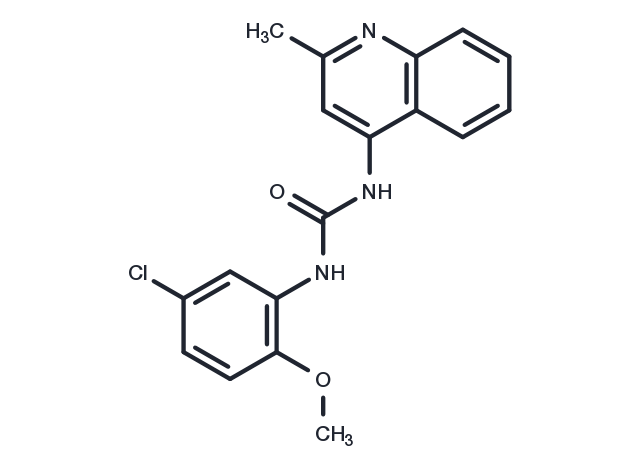Powder: -20°C for 3 years | In solvent: -80°C for 1 year


PQ401 (IGF-1R Inhibitor II) suppresses autophosphorylation of IGF-1R domain(IC50<1 μM).

| Pack Size | Availability | Price/USD | Quantity |
|---|---|---|---|
| 5 mg | In stock | $ 63.00 | |
| 10 mg | In stock | $ 97.00 | |
| 25 mg | In stock | $ 187.00 | |
| 50 mg | In stock | $ 316.00 | |
| 100 mg | In stock | $ 472.00 | |
| 500 mg | In stock | $ 987.00 | |
| 1 mL * 10 mM (in DMSO) | In stock | $ 68.00 |


| Description | PQ401 (IGF-1R Inhibitor II) suppresses autophosphorylation of IGF-1R domain(IC50<1 μM). |
| Targets&IC50 | IGF-1R:<1 μM |
| In vivo | Treated mice received 50 or 100 mg/kg PQ401 prepared in 8% polysorbate 80/ethanol/PBS, administered i.p. thrice a week. |
| Kinase Assay | IGF-IR Peptide Autophosphorylation: One microgram of constitutively active IGF-IR kinase domain peptide isincubated +/? varying concentrations of PQ 401 in 2% DMSO in 40 mM Tris (pH 7.4), 80 μMEGTA, 0.25% 2-mercaptoethanol, 80 μM Na3VO4, 10 mM MgCl2, and 2 mM MnCl2 for 20 minutes. ATP isthen added at a final concentration of 20 μM. Autophosphorylation of the kinase domain peptide isallowed to occur for 20 minutes at 22℃. The reaction isstopped by the addition of SDS-reducing buffer and the samples are run on SDS-PAGE. Following transfer to nitrocellulose membrane, peptide autophosphorylation isdetermined by Western blotting employing an antibody against phosphotyrosine (PY20). |
| Cell Research | The inhibitory effects of diaryl urea on breast cancer cell growth are determined using a CyQuant cell proliferation assay kit. MCF-7 or MCNeuA cells are plated in 96-well plates (5 × 103 per well) in phenol red-free DMEM supplemented with 10% FCS. One plate isprepared for each harvest day. Cells are allowed to adhere overnight and are then treated with various concentrations of diaryl urea or DMSO as a vehicle control. Microplate cultures are harvested on days 0, 1, 2, and 3 by inverting the microplate onto paper towels with gentle blotting to remove growth medium without disrupting adherent cells. Each plate iskept at ?80 ℃ until the end of the experiment (day 3) when all of the plates are thawed and assayed together. After thawing, 200 μL of CyQuant GR solution are added to each well and the plates are incubated in the dark for 2 to 5 minutes. Fluorescence ismeasured with a SpectraMax Gemini XS fluorescence microplate reader with 480-nm excitation and 520-nm emission. Proliferation index iscalculated as the percent of nucleotide content versus control cells at day 0.(Only for Reference) |
| Synonyms | IGF-1R Inhibitor II |
| Molecular Weight | 341.79 |
| Formula | C18H16ClN3O2 |
| CAS No. | 196868-63-0 |
Powder: -20°C for 3 years | In solvent: -80°C for 1 year
Ethanol: 8.5 mg/mL (25 mM)
DMSO: 17.1 mg/mL (50 mM)
You can also refer to dose conversion for different animals. More
bottom
Please see Inhibitor Handling Instructions for more frequently ask questions. Topics include: how to prepare stock solutions, how to store products, and cautions on cell-based assays & animal experiments, etc.
PQ401 196868-63-0 Apoptosis Tyrosine Kinase/Adaptors IGF-1R MCF-7 cells breast inhibit caspase PQ-401 PQ 401 autophosphorylation IGF-1R Inhibitor II cancer Inhibitor inhibitor
